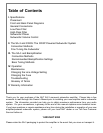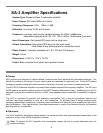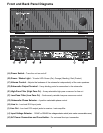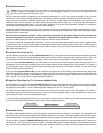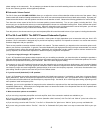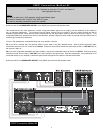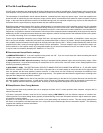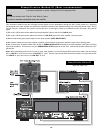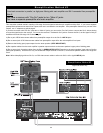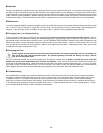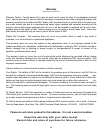
The SA-3 and Biamplification
All NHT tower loudspeakers are designed with dual sets of binding posts to allow for biamplification. Biamplification is the use of two sep-
arate amplifiers, one to power the low frequency (subwoofer) drivers and one to power the upper frequency (midrange / tweeter) drivers.
The advantages of biamplification include reduced distortion, increased dynamic range and power output. Since both amplifiers are
spared the task of reproducing the entire frequency range, both are able to concentrate all their headroom toward a specific frequency
range. In the event that the speakers are driven to elevated listening levels, the subwoofer amplifier may clip first, but this distortion will
be isolated from the upper frequency ranges because they are amplified separately.
Biamplifying tower speakers with the SA-3 results in added benefits, as it transforms their built-in subwoofer sections into fully adjustable
powered subwoofers. Using the SA-3’s onboard bass tuning functions, the user can fine-tune a tower loudspeaker’s bass response in
a specific listening environment. For example, if the speakers are used in a room that tends to under-emphasize or over-emphasize low
frequencies, it is possible to increase or decrease the volume level of the subwoofer sections independently of the upper driver sections.
Additionally, the SA-3’s low-pass crossover allows the user to adjust the rolloff of low frequencies to the subwoofer sections of the speak-
ers, for further fine-tuning of low- to mid-bass frequencies.
Towers may be biamplified monaurally using a single SA-3 and a full-range main (stereo) amplifier, or biamplified in stereo using two
SA-3’s and a main amplifier. Additionally, the towers may be biamplified either in series or in parallel. Wired in series (Method #1), the
main amplifier receives a filtered line-level signal via the high-pass output from the SA-3. Wired in parallel (Method #2), both the main
amplifier and the SA-3 receive full-range signals directly from the preamplifier. The main amplifier may be a stand-alone stereo unit,
dual monoblocks, or the amplifier section of an integrated amplifier or A/V receiver that features “Pre-Out” and “Main-In” jacks. The SA-
3 may be used to successfully biamplify NHT Models 2.9, 3.3 and VT-2.
Recommended biamplification settings:
1) SUBWOOFER PHASE: 0°. If the main amplifier inverts phase, use 180°. If you are unsure about this, select the setting that results
in higher bass output with the volume control unchanged.
2) SUBWOOFER VOLUME: Adjust for accuracy, listening for seamless blending between upper and lower frequency ranges. When
changing electronics, it may become necessary to re-adjust the SA-3’s volume level, since the correct volume setting depends on the
sensitivity of partnering electronics.
3) HIGH PASS F
C
: 65Hz. THIS SETTING ONLY APPLIES TO BIAMPLIFICATION CONNECTION METHOD #1. IF YOU ARE USING
METHOD #2, IGNORE THIS SETTING. Set the SA-3’s high-pass filter to its lowest setting to ensure that the SA-3’s high-pass filter
does not interfere with the tower speaker’s passive crossover. In other words, the SA-3 sends only information from 65Hz-up to the
main amplifier (and consequently the speaker’s upper range drivers). The speaker itself then filters the signal further, according to the
high-pass filter designed into its passive crossover.
4) LOW PASS FC: 150Hz. Set the SA-3’s low-pass filter to its highest setting so that the SA-3’s low-pass filter does not interfere with
the tower speaker’s passive crossover. In other words, the SA-3 sends only information below 150Hz to the speaker’s subwoofer sec-
tion. The speaker itself then filters the signal further, according to the low-pass filter designed into its passive crossover.
Biamplification: Bass Tuning Methods
Following are two bass tuning methods that can be employed to further “dial in” a tower speaker’s bass response, using the SA-3’s
onboard low-pass filter.
1) If there is excessive mid-bass, lower the SA-3’s low-pass setting (LOW PASS Fc) until the mid-bass response is smoothed out.
Lowering the SA-3’s low-pass setting allows gradually increased filtering of the bass information before the signal reaches the speak-
er’s passive crossover network.
2) If there is not enough low bass output, lower the SA-3’s low-pass setting and increase its volume. This bass tuning method allows
the listener to decrease the mid-bass response, but in conjunction with increased output from the subwoofer amplifier. This effectively
increases the audibility of low bass information.
3) Experiment with phase.
9





